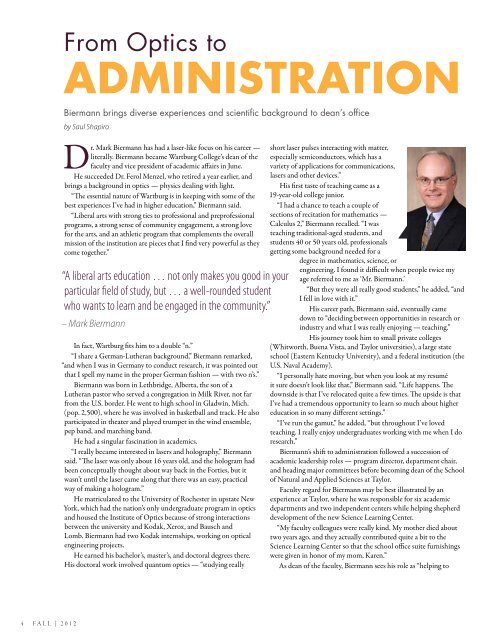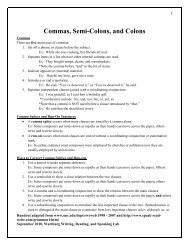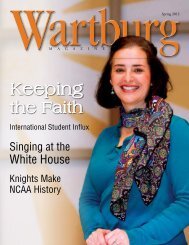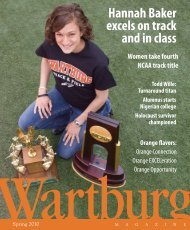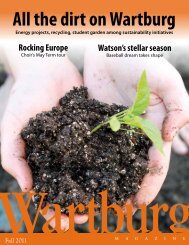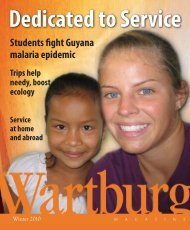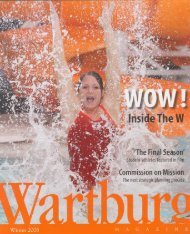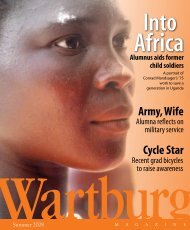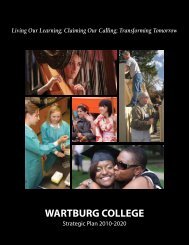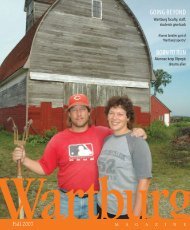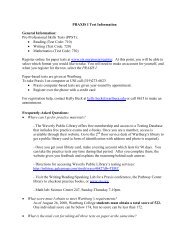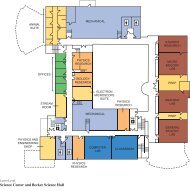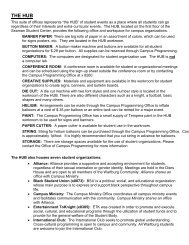You also want an ePaper? Increase the reach of your titles
YUMPU automatically turns print PDFs into web optimized ePapers that Google loves.
4 FALL | 2012<br />
From optics to<br />
AdMiniStrAtion<br />
biermann brings diverse experiences and scientific background to dean’s office<br />
by Saul Shapiro<br />
Dr. Mark Biermann has had a laser-like focus on his career —<br />
literally. Biermann became <strong>Wartburg</strong> <strong>College</strong>’s dean of the<br />
faculty and vice president of academic affairs in June.<br />
He succeeded Dr. Ferol Menzel, who retired a year earlier, and<br />
brings a background in optics — physics dealing with light.<br />
“The essential nature of <strong>Wartburg</strong> is in keeping with some of the<br />
best experiences I’ve had in higher education,” Biermann said.<br />
“Liberal arts with strong ties to professional and preprofessional<br />
programs, a strong sense of community engagement, a strong love<br />
for the arts, and an athletic program that complements the overall<br />
mission of the institution are pieces that I find very powerful as they<br />
come together.”<br />
“A liberal arts education … not only makes you good in your<br />
particular field of study, but … a well-rounded student<br />
who wants to learn and be engaged in the community.”<br />
– Mark Biermann<br />
In fact, <strong>Wartburg</strong> fits him to a double “n.”<br />
“I share a German-Lutheran background,” Biermann remarked,<br />
“and when I was in Germany to conduct research, it was pointed out<br />
that I spell my name in the proper German fashion — with two n’s.”<br />
Biermann was born in Lethbridge, Alberta, the son of a<br />
Lutheran pastor who served a congregation in Milk River, not far<br />
from the U.S. border. He went to high school in Gladwin, Mich.<br />
(pop. 2,500), where he was involved in basketball and track. He also<br />
participated in theater and played trumpet in the wind ensemble,<br />
pep band, and marching band.<br />
He had a singular fascination in academics.<br />
“I really became interested in lasers and holography,” Biermann<br />
said. “The laser was only about 16 years old, and the hologram had<br />
been conceptually thought about way back in the Forties, but it<br />
wasn’t until the laser came along that there was an easy, practical<br />
way of making a hologram.”<br />
He matriculated to the University of Rochester in upstate New<br />
York, which had the nation’s only undergraduate program in optics<br />
and housed the Institute of Optics because of strong interactions<br />
between the university and Kodak, Xerox, and Bausch and<br />
Lomb. Biermann had two Kodak internships, working on optical<br />
engineering projects.<br />
He earned his bachelor’s, master’s, and doctoral degrees there.<br />
His doctoral work involved quantum optics — “studying really<br />
short laser pulses interacting with matter,<br />
especially semiconductors, which has a<br />
variety of applications for communications,<br />
lasers and other devices.”<br />
His first taste of teaching came as a<br />
19-year-old college junior.<br />
“I had a chance to teach a couple of<br />
sections of recitation for mathematics —<br />
Calculus 2,” Biermann recalled. “I was<br />
teaching traditional-aged students, and<br />
students 40 or 50 years old, professionals<br />
getting some background needed for a<br />
degree in mathematics, science, or<br />
engineering. I found it difficult when people twice my<br />
age referred to me as ‘Mr. Biermann.’<br />
“But they were all really good students,” he added, “and<br />
I fell in love with it.”<br />
His career path, Biermann said, eventually came<br />
down to “deciding between opportunities in research or<br />
industry and what I was really enjoying — teaching.”<br />
His journey took him to small private colleges<br />
(Whitworth, Buena Vista, and Taylor universities), a large state<br />
school (Eastern Kentucky University), and a federal institution (the<br />
U.S. Naval Academy).<br />
“I personally hate moving, but when you look at my resumé<br />
it sure doesn’t look like that,” Biermann said. “Life happens. The<br />
downside is that I’ve relocated quite a few times. The upside is that<br />
I’ve had a tremendous opportunity to learn so much about higher<br />
education in so many different settings.”<br />
“I’ve run the gamut,” he added, “but throughout I’ve loved<br />
teaching. I really enjoy undergraduates working with me when I do<br />
research.”<br />
Biermann’s shift to administration followed a succession of<br />
academic leadership roles — program director, department chair,<br />
and heading major committees before becoming dean of the School<br />
of Natural and Applied Sciences at Taylor.<br />
Faculty regard for Biermann may be best illustrated by an<br />
experience at Taylor, where he was responsible for six academic<br />
departments and two independent centers while helping shepherd<br />
development of the new Science Learning Center.<br />
“My faculty colleagues were really kind. My mother died about<br />
two years ago, and they actually contributed quite a bit to the<br />
Science Learning Center so that the school office suite furnishings<br />
were given in honor of my mom, Karen.”<br />
As dean of the faculty, Biermann sees his role as “helping to


